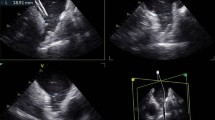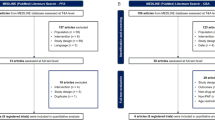Abstract
Purpose
To perform a systematic review of reports in which the AngioVac™ percutaneous vacuum-assisted aspiration system was successfully used to debulk or remove vegetations prior to percutaneous lead extraction.
Methods
We included all studies and case reports that used a percutaneous aspiration technique for vegetation removal or debulking with percutaneous lead extraction for patients with lead-associated endocarditis. Ten reports and retrospective data from our centers were used, which included a total of 88 patients and 205 leads.
Results
The percutaneous aspiration procedure was completely or partially successful in 86 patients (97.7%). The lead extraction procedure itself was successful in 87 patients (98.9%). The aspiration procedure and lead extraction were done concomitantly in 81 patients (92.0%). Four patients (4.5%) had major complications (two due to vascular injuries, one due to coronary sinus injury, and one due to tricuspid valve injury). There were no complications from the aspiration procedure, and no cases were associated with procedure-related mortality.
Conclusion
While patients with large vegetations have historically been referred for surgical lead extraction, data are lacking in its techniques and outcomes. Existing data suggest that percutaneous vacuum-assisted aspiration for vegetation removal or debulking in endocarditis prior to or concurrent with percutaneous lead extraction has a high success rate with a low complication rate across a broad series of patients.


Similar content being viewed by others
References
Wazni O, Epstein LM, Carrillo RG, Love C, Adler SW, Riggio DW, et al. Lead extraction in the contemporary setting: the LExICon study: an observational retrospective study of consecutive laser lead extractions. J Am Coll Cardiol. 2010;55:579–86.
Roux JF, Pagé P, Dubuc M, et al. Laser lead extraction: predictors of success and complications. Pacing Clin Electrophysiol. 2007;30:214–20.
Mazzone P, Migliore F, Bertaglia E, Facchin D, Daleffe E, Calzolari V, et al. Safety and efficacy of the new bidirectional rotational Evolution® mechanical lead extraction sheath: results from a multicentre Italian registry. Europace. 2018;20:829–34.
Baddour LM, Epstein AE, Erickson CC, Knight BP, Levison ME, Lockhart PB, et al. Update on cardiovascular implantable electronic device infections and their management: a scientific statement from the American Heart Association. Circulation. 2010;121:458–77.
Sohail MR, Uslan DZ, Khan AH, Friedman PA, Hayes DL, Wilson WR, et al. Management and outcome of permanent pacemaker and implantable cardioverter-defibrillator infections. J Am Coll Cardiol. 2007;49:1851–9.
Massoure PL, Reuter S, Lafitte S, et al. Pacemaker endocarditis: clinical features and management of 60 consecutive cases. Pacing Clin Electrophysiol. 2007;30:12–9.
Greenspon AJ, Le KY, Prutkin JM, et al. Influence of vegetation size on the clinical presentation and outcome of lead-associated endocarditis: results from the MEDIC registry. JACC Cardiovasc Imaging. 2014;7:541–9.
Grammes JA, Schulze CM, Al-Bataineh M, et al. Percutaneous pacemaker and implantable cardioverter-defibrillator lead extraction in 100 patients with intracardiac vegetations defined by transesophageal echocardiogram. J Am Coll Cardiol. 2010;55:866–94.
Meier-Ewert HK, Gray ME, John RM. Endocardial pacemaker or defibrillator leads with infected vegetations: a single-center experience and consequences of transvenous extraction. Am Heart J. 2003;146:339–44.
Kusumoto FM, Schoenfeld MH, Wilkoff BL, Berul CI, Birgersdotter-Green UM, Carrillo R, et al. 2017 HRS expert consensus statement on cardiovascular implantable electronic device lead management and extraction. Heart Rhythm. 2017;14:e503–51.
Gaca JG, Lima B, Milano CA, Lin SS, Davis RD, Lowe JE, et al. Laser-assisted extraction of pacemaker and defibrillator leads: the role of the cardiac surgeon. Ann Thorac Surg. 2009;87:1446–51.
Brunner MP, Cronin EM, Wazni O, Baranowski B, Saliba WI, Sabik JF, et al. Outcomes of patients requiring emergent surgical or endovascular intervention for catastrophic complications during transvenous lead extraction. Heart Rhythm. 2014;11:419–25.
Chaudhry UA, Harling L, Ashrafian H, Athanasiou C, Tsipas P, Kokotsakis J, et al. Surgical management of infected cardiac implantable electronic devices. Int J Cardiol. 2016;203:714–21.
Patel N, Azemi T, Zaeem F, Underhill D, Gallagher R, Hagberg R, et al. Vacuum assisted vegetation extraction for the management of large lead vegetations. J Card Surg. 2013;28:321–4.
Moriarty JO, Patel KO, Bradfield JA. Vacuum-assisted debulking of a prohibitively large tricuspid valve vegetation prior to percutaneous laser lead extraction. J Innov Cardiac Rhythm Manage. 2014;5:1544–8.
Issa ZF, Goswami NJ. Simultaneous lead extraction and vacuum-assisted vegetation removal. Heart Rhythm Case Rep. 2015;2:17–9.
Schaerf RH, Najibi S, Conrad J. Percutaneous vacuum-assisted thrombectomy device used for removal of large vegetations on infected pacemaker and defibrillator leads as an adjunct to lead extraction. J Atr Fibrillation. 2016;9:1455.
Jones BM, Wazni O, Rehm SJ, Shishehbor MH. Fighting fungus with a laser and a hose: management of a giant candida albicans implantable cardioverter-defibrillator lead vegetation with simultaneous Angiovac aspiration and laser sheath lead extraction. Catheter Cardiovasc Interv. 2018;91:318–21.
Edla S, Boshara A, Neupane S, Hassan S. Internal jugular venous approach to percutaneous vacuum-assisted debulking of large lead vegetations prior to lead extraction. JACC Clin Electrophysiol. 2018;4:147–8.
Vaidya GN, Deam AG. Simultaneous suction debulking of lead vegetation prior to percutaneous lead extraction. J Cardiol Cases. 2018;18:17–9.
Godara H, Jia KQ, Augostini RS, Houmsse M, Okabe T, Hummel JD, et al. Feasibility of concomitant vacuum-assisted removal of lead-related vegetations and cardiac implantable electronic device extraction. J Cardiovasc Electrophysiol. 2018;29:1460–6.
Patel N, Mcdonald ML, Bradford NS, et al. AngioVac debulking in endocarditis patients with large, device-related vegetations. J Innov Cardiac Rhythm Manage. 2018;9:3291–6.
Starck CT, Eulert-Grehn J, Kukucka M, Eggert-Doktor D, Dreizler T, Haupt B, et al. Managing large lead vegetations in transvenous lead extractions using a percutaneous aspiration technique. Expert Rev Med Devices. 2018;15:757–61.
Polewczyk A, Jacheć W, Tomaszewski A, Brzozowski W, Czajkowski M, Opolski G, et al. Lead-related infective endocarditis: factors influencing early and long-term survival in patients undergoing transvenous lead extraction. Heart Rhythm. 2017;14:43–9.
Gomes S, Cranney G, Bennett M, Giles R. Long-term outcomes following transvenous lead extraction. Pacing Clin Electrophysiol. 2016;39:345–51.
Kim Y, Rusia A, Do K, Huntsinger M, Doshi RN. Pulmonary arterial pressure increases in patients undergoing transvenous laser lead extraction (TVLLE): implications for percutaneous intra-cardiac aspiration [B-AB25-02]. Heart Rhythm. 2018;15:S63–4.
Author information
Authors and Affiliations
Corresponding author
Ethics declarations
Conflict of interest
The authors declare that they have no conflicts of interest.
Consent irrelevant
Our IRB has approved this study.
Informed consent
Informed consent is not applicable.
Additional information
Publisher’s note
Springer Nature remains neutral with regard to jurisdictional claims in published maps and institutional affiliations.
Rights and permissions
About this article
Cite this article
Rusia, A., Shi, A.J. & Doshi, R.N. Vacuum-assisted vegetation removal with percutaneous lead extraction: a systematic review of the literature. J Interv Card Electrophysiol 55, 129–135 (2019). https://doi.org/10.1007/s10840-019-00555-6
Received:
Accepted:
Published:
Issue Date:
DOI: https://doi.org/10.1007/s10840-019-00555-6




